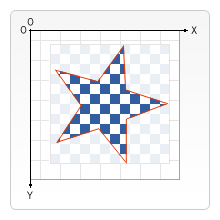CanvasRenderingContext2D: clip() method
Baseline Widely available
This feature is well established and works across many devices and browser versions. It’s been available across browsers since July 2015.
The
CanvasRenderingContext2D.clip()
method of the Canvas 2D API turns the current or given path into the current clipping
region. The previous clipping region, if any, is intersected with the current or given
path to create the new clipping region.
In the image below, the red outline represents a clipping region shaped like a star. Only those parts of the checkerboard pattern that are within the clipping region get drawn.

Note:
Be aware that the clipping region is only constructed from
shapes added to the path. It doesn't work with shape primitives drawn directly to the
canvas, such as fillRect().
Instead, you'd have to use rect() to
add a rectangular shape to the path before calling clip().
Syntax
clip()
clip(path)
clip(fillRule)
clip(path, fillRule)
Parameters
Return value
None (undefined).
Examples
A simple clipping region
This example uses the clip() method to create a clipping region according
to the shape of a circular arc. Two rectangles are then drawn; only those parts within
the clipping region are rendered.
HTML
<canvas id="canvas"></canvas>
JavaScript
The clipping region is a full circle, with its center at (100, 75), and a radius of 50.
const canvas = document.getElementById("canvas");
const ctx = canvas.getContext("2d");
// Create circular clipping region
ctx.beginPath();
ctx.arc(100, 75, 50, 0, Math.PI * 2);
ctx.clip();
// Draw stuff that gets clipped
ctx.fillStyle = "blue";
ctx.fillRect(0, 0, canvas.width, canvas.height);
ctx.fillStyle = "orange";
ctx.fillRect(0, 0, 100, 100);
Result
Specifying a path and a fillRule
This example saves two rectangles to a Path2D object, which is then made the current
clipping region using the clip() method. The "evenodd" rule
creates a hole where the clipping rectangles intersect; by default (with the
"nonzero" rule), there would be no hole.
HTML
<canvas id="canvas"></canvas>
JavaScript
const canvas = document.getElementById("canvas");
const ctx = canvas.getContext("2d");
// Create clipping path
let region = new Path2D();
region.rect(80, 10, 20, 130);
region.rect(40, 50, 100, 50);
ctx.clip(region, "evenodd");
// Draw stuff that gets clipped
ctx.fillStyle = "blue";
ctx.fillRect(0, 0, canvas.width, canvas.height);
Result
Creating a complex clipping region
This example uses two paths, a rectangle and a square to create a complex clipping
region. The clip() method is called twice, first to set the current
clipping region to the circle using a Path2D object, then again to
intersect the circle clipping region with a square. The final clipping region is a shape
representing the intersection of the circle and the square.
HTML
<canvas id="canvas"></canvas>
JavaScript
const canvas = document.getElementById("canvas");
const ctx = canvas.getContext("2d");
// Create two clipping paths
let circlePath = new Path2D();
circlePath.arc(150, 75, 75, 0, 2 * Math.PI);
let squarePath = new Path2D();
squarePath.rect(85, 10, 130, 130);
// Set the clip to the circle
ctx.clip(circlePath);
// Set the clip to be the intersection of the circle and the square
ctx.clip(squarePath);
// Draw stuff that gets clipped
ctx.fillStyle = "blue";
ctx.fillRect(0, 0, canvas.width, canvas.height);
Result
Specifications
| Specification |
|---|
| HTML Standard # dom-context-2d-clip-dev |
Browser compatibility
BCD tables only load in the browser
See also
- The interface defining this method:
CanvasRenderingContext2D